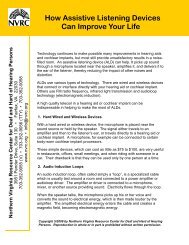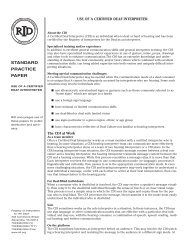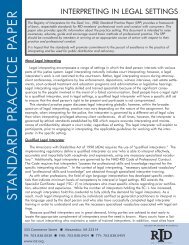Video Remote Interpreting Standard Practice Paper - Registry of ...
Video Remote Interpreting Standard Practice Paper - Registry of ...
Video Remote Interpreting Standard Practice Paper - Registry of ...
Create successful ePaper yourself
Turn your PDF publications into a flip-book with our unique Google optimized e-Paper software.
STANDARD PRACTICE PAPER<br />
⊳<br />
Click Here to Return to<br />
the General Section <strong>of</strong><br />
the VRI SPP<br />
About<br />
<strong>Video</strong> remote interpreting (VRI) can be an effective and appropriate way to deliver interpreting services<br />
in educational settings. Factors to consider before this technology is utilized include: student characteristics,<br />
content areas, readiness protocols, technology specifications, preparation and training.<br />
Student Characteristics<br />
Students receiving interpreting services through VRI need to be familiar with the specific role and<br />
responsibilities <strong>of</strong> the educational interpreter prior to initiating services through this media. For that reason,<br />
it is recommended that consumers in the K-12 environment be no younger than middle school age<br />
(6th grade and above). 1 Students at the postsecondary level can typically receive interpreting services<br />
through this venue with basic orientation to the technology; however, onsite interpreters are more effective<br />
when the classroom environment is highly interactive.<br />
Content Areas<br />
Careful consideration should be given to course content and teaching methods when opting to use<br />
VRI services. Issues impacting the auditory environment (e.g., poor acoustics) and the interpreter’s ability<br />
to visually refer to content (e.g., not being able to see the blackboard) must be resolved. VRI is more<br />
appropriately used in lecture format classes. Curriculum with highly visual topics such as mathematics or<br />
courses involving extensive work on the board may exclude the interpreter from seeing the vital content,<br />
thereby impacting the accuracy <strong>of</strong> the interpretation. VRI is also less effective in classes taught using the<br />
Socratic Method, such as law, philosophy and medicine since the auditory environment can be difficult<br />
for the remote interpreter and result in limited access for the deaf consumer.<br />
Readiness Protocol<br />
When working with public schools and universities, firewall issues, security concerns and network<br />
traffic patterns must be addressed. Technical support personnel available to address these issues can<br />
vary at each institution. Staff from Information Technology (IT) and/or Instructional Support Departments<br />
should be included in the planning stages along with Disability Support Services (DSS) or Special<br />
Education personnel. Once it is established that the educational institution has the necessary resources<br />
to use VRI effectively, students and faculty who will use the service should be included in test calls and<br />
preliminary orientation meetings when possible. These meetings will provide consumers with general<br />
information on how the equipment works. It will also give faculty members guidance for best practice<br />
while this technology is being used. During this meeting, both students and faculty members will have<br />
an opportunity to ask questions and be provided the contact information for IT support services.<br />
Technology<br />
VIDEO REMOTE INTERPRETING<br />
educational setting<br />
In educational settings, the type <strong>of</strong> equipment chosen can depend, to a large extent, on the need for<br />
portability. Laptops that are equipped with s<strong>of</strong>tware and Web cams or desktop personal units which integrate<br />
the s<strong>of</strong>tware and Web cam in one portable unit are both readily available. Either <strong>of</strong> these options<br />
can be moved to various locations at an institution. Laptops using outboard devices (Web cams and<br />
wireless microphones) should be configured with care. It is important that the total CPU load on a laptop<br />
configuration is adjusted to accommodate the CPU load the devices demand in order to ensure that<br />
video quality is not sacrificed. 2<br />
1 Betts, J., Mckay, J., Maruff, P., & Anderson, V. (n.d.). The development <strong>of</strong> sustained attention in children: the effect <strong>of</strong><br />
age and task load. Child Neuropsychology , 12, 205-221.<br />
2 Polycom, Inc. (n.d.). Configuring <strong>Video</strong> and Audio Devices for Use with Polycom PVX. Retrieved from http:www.polycom.com/global/documents/support/user/products/video/select_audio_video_devices_for_pvx.pdf<br />
<strong>Video</strong> <strong>Remote</strong> <strong>Interpreting</strong> - Educational 8






